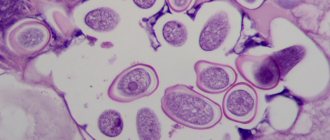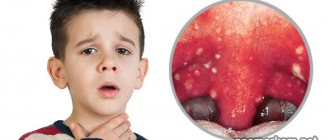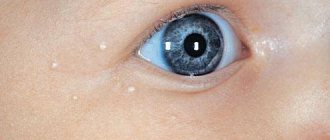The birth of a baby is a great miracle and happiness for every family. However, during this period, parents are faced with a large number of issues in raising and maintaining health. Not all changes indicate the presence of serious diseases. White lumps in a baby's stool can greatly frighten parents. Is this really a reason to worry and what state of stool can be considered normal.
Each child is unique, so after birth, the gastrointestinal tract continues the process of formation. This takes varying periods of time. In some cases, it takes several years for the digestive system to begin functioning properly. It has been scientifically established that only an eight-year-old child’s stomach and intestines function like those of an adult. Until this time, you need to be extremely careful in choosing your diet. Otherwise, the risk of various eating disorders increases. White lumps in a baby's stool can be caused by various problems. It is necessary to take into account additional symptoms that may occur in the newborn.
Causes
Most often, grains in a baby's stool indicate overeating. To eliminate a negative symptom, it is enough to reduce the portion for the next day. However, we should not forget about meeting needs. If food is poorly digested, small particles will be present in the baby's stool. In the stomach and intestines, the process of breaking down individual components with the help of special enzymes takes place. After birth, a child’s body is only at the stage of formation, so it may lack certain elements. In this case, many individual parts are excreted from the body in the feces.
Stool directly depends on the type of feeding, so it may change if complementary foods are introduced. Pediatricians say that babies should be fed food other than breast milk only after six months. During this period, his body will be able to fully adapt to the new food. More recently, this process was recommended to be carried out from the age of three months. However, later it was possible to identify the negative effect of this process. For example, in this case, the risk of developing allergies, improper functioning of the gastrointestinal tract and dysbacteriosis increases.
The best nutrition for a baby is mother's milk. This feeding option is also supported by the Ministry of Health. Today there is no mixture that would be better than the natural composition in terms of the amount of vitamins and minerals. Breast milk is specially created by nature in order to fully satisfy all the requirements of the child's body. During feeding, an additional bond is also established between mother and baby. Changes can be immediately detected in an infant's stool if they switch to artificial feeding. To eliminate a negative symptom, possible allergens and foods that negatively affect metabolism should be excluded from the diet. During breastfeeding, it is not allowed to drink alcoholic beverages or smoke.
Streaks may appear in the stool even if the mother adheres to the diet completely. In this case, you need to pay attention to the amount of food that the child eats daily. Today, most mothers put the baby to the breast on demand. Thanks to this, the baby can eat well and sleep sweetly.
If you put your baby to your breast regularly, he feels protected, because a strong connection is established between him and his mother. Mommy must control the amount of milk, although the procedure is quite complicated. In this case, it is best to rely on natural processes. After a certain period, the baby’s saturation and the amount of breast milk will regulate independently. It is also not recommended to forcibly remove the breast from the baby during feeding. Additionally, it should be noted that the baby’s diet contains the most foremilk. It is not greasy, so it does not burden the stomach and intestines. Hind milk is fatty, but can only be obtained if the breast is sucked completely.
Black spots in a child’s stool: what is it?
Any black inclusions in stool - strings, grains, grains of sand, grains - are called black dots. If you find black grains or black threads in your child’s stool, do not rush to panic! These are not foreign bodies. And not parasites. In most cases, these are poorly digested particles of what the baby ate. As a rule, these can be:
- food fragments;
- iron compounds;
- honey. drugs.
To determine the nature of the origin of black dots and strings in a child’s stool, remember what he ate over the past three days. So, if you find black strings in your child’s stool (pictured), then most likely the baby recently ate a banana, apple, or prune.
But black grains in feces, as a rule, appear after eating raspberries, currants, persimmons, kiwi and poppy seed buns.
If we talk about black spots in the stool of a child of any age, then the cause of their occurrence may be an excess of iron in the diet, as well as taking certain medications. Perhaps you often feed your baby eggs, liver and other offal? Then his menu needs to be revised a little, and the feces will return to normal. But when taking medications, you should always consult with the doctor who prescribed them!
Expert opinion
White grains may appear in the stool in case of excessive feeding, high fat content of milk and irregular feeding to the breast. Pediatricians advise carefully monitoring other symptoms that the baby has. If he feels well, the digestion process will normalize within a short time. However, you should not hesitate to contact a specialist in case of excessive gas formation and negative changes in behavior. In some cases, putting the baby to the breast every hour helps change the situation for the better. To further stimulate the body and improve microflora, special additives are used. The correct drugs can be selected only after all the necessary tests have been carried out.
Symptom manifestation on artificial feeding
If a child eats formula, then completely different reactions occur in his digestive system. The choice of composition should be made only by a professional who can analyze the individual characteristics of the child’s body.
White streaks will not appear in feces if the volume is chosen correctly. In this case, the age and weight of the baby are taken into account.
Using a bottle, you can easily determine the amount of food eaten. Mommy should not act contrary to the opinion of the pediatrician.
The volume is regulated only by them. Otherwise, flakes may be found in the stool, which indicate digestive problems.
A negative reaction in the baby’s body can also occur if there is a sudden change in the composition of the drink.
A radical change in components will lead to inclusions of white components in the child’s stool. A negative reaction is also noticeable in the form of profuse rashes on the skin and problems with intestinal function. If the mixture is chosen incorrectly, there will be lumps in the stool. In this case, you should feed exclusively with the composition that is completely suitable for the baby’s body.
Candidiasis
Colonies of the fungus Candida in the form of white spots that float to the surface of the water
Candida fungus is a common cause of yeast infections. In humans, it is considered a natural fungus that helps the body digest food and absorb nutrients. For those with a weak immune system, white spots in the stool are quite common. This may be a sign of overgrowth of this fungus, in such cases the spots are clusters of it. This disease is known as candidiasis or thrush.
Candida often leads to symptoms such as fatigue, skin problems, and confusion among others.
The "good" bacteria in the body help keep yeast under control. High consumption of sugar, carbohydrates and antibiotics can reduce the number of these bacteria, causing the fungus to get out of control. Other causes of candida overgrowth include emotional stress, high alcohol consumption, and oral contraceptives.
This may manifest itself in the following symptoms:
- Fungal infection on the skin and nails
- Seasonal allergies
- Outbreak of autoimmune disorders
- Fatigue
- Bloating, constipation, or diarrhea
- Anxiety and mood swings
- Difficulty concentrating or brain fog.
There are some simple tests that can be used to determine the level of this fungus in the body. The main ones include a general analysis of blood, stool and urine. The doctor will then be able to prescribe the best treatment for the problem.
Treatment for candida is aimed at stopping the overgrowth of yeast and restoring friendly bacteria. In some cases, therapy will also include treatment of the intestines to stop the infection from entering the bloodstream.
Meconium concept
Immediately after birth, changes begin to occur in the baby’s body. At the first stage, accumulations that came inside from the mother’s womb must be released from the intestines. The process is long, because the fetus spent nine months in the woman’s tummy. The first bowel movement is called meconium. This category of feces is very dense and hard. Most often it has a green tint. The process of passing meconium should be completed no later than the second day. After this, the stool will look like porridge, in which strings of meconium will occasionally be present. Such bowel movements are transitory in nature. The stool becomes normal after the mother, together with the doctors, is able to establish the procedure for feeding the child.
What can cause balls to appear in stool?
Changed structure and color of stool can signal disturbances and malfunctions occurring in the body. Therefore, when faced with such a problem, you should pay close attention to your health and try to understand the reason for this phenomenon. After all, balls in the stool may indicate an inflammatory process occurring in the large intestine.
What do the white balls indicate?
Feces may contain white specks for the following reasons:
- inflammatory process occurring in the intestines;
- the presence of parasites that have already laid eggs;
- intestinal candidiasis;
- taking medications whose remains have not yet left the body;
- erosion of the large intestine.
The course of the inflammatory process of the intestines can be recognized by the appearance of white lumps in the stool, which appear steadily over several days. If such lumps have a heterogeneous structure, then we can talk about an open focus of inflammation. In this case, a person may feel painful cramps in the stomach area throughout the day.
If the cause of the appearance of white balls in the stool is the vital activity of parasites, then this phenomenon occurs once, or for two days, but no more. After a certain time, it may arise again, but there is no permanence in such a violation.
With helminthiasis, a person may notice a lack of appetite, pale skin, allergic rashes all over the body, frequent headaches and nausea. A laboratory analysis of stool can make an accurate diagnosis.
In this case, the type of parasite is determined and the doctor prescribes appropriate treatment.
Another reason why white spots in the form of balls can be found in stool is candidiasis. This disease refers to fungal infections that are sexually transmitted. With this disease, the surface of the intestinal mucosa becomes covered with a white coating. Intestinal thrush can be recognized by the following symptoms:
- white particles in stool;
- itching and burning when visiting the toilet in the anorectal area;
- irritation of the skin surface near the anus;
- stomach twists;
- lack of appetite;
- unpleasant cramps in the lower abdomen;
- Rumbling in the stomach not associated with food intake.
It is important to pay attention to such signs in time and be sure to visit a doctor. Otherwise, a person may face serious complications.
Black balls in stool
Black balls in stool may be associated with a safe factor such as excessive consumption of pears, bananas or apples. All these fruits lead to dark streaks appearing in the stool.
Black inclusions can also be associated with foods such as beets, liver, and blood sausage. And if this phenomenon goes away on its own after a few days, and the person does not observe any other disturbances in his well-being and body, then there is no need to worry.
The food is completely digested, and the stool returns to its previous color.
Sometimes the cause of black balls in the stool can be taking certain medications. Most often this applies to activated carbon, Ibuprofen, Paracetamol, Vikalin. This reason is also considered quite safe.
Sometimes pathologies affecting the gastric and intestinal tract can cause black balls in the stool. This phenomenon is caused by bleeding, which can begin inside the body. In addition to black spots in the stool, a person may experience frequent dizziness.
He may be bothered by physical weakness, he may notice paleness of the skin. Blood pressure will also decrease, and the heartbeat, on the contrary, will increase. In this case, you should immediately consult a doctor.
Black balls in the stool may indicate diseases such as:
- Haemorrhoids.
- Gastritis, diverticulitis, gastric ulcer.
- Crohn's disease.
- Inflammation of the gastric mucosa.
- The presence of a malignant tumor in one of the upper parts of the intestinal and gastric tract.
If the cause of this phenomenon is an intestinal infection, then the feces themselves turn greenish, emitting a fetid and pungent odor. At such a moment, a person complains of attacks of nausea and vomiting, his temperature rises, and the feverish state is replaced by chills.
Features of the chair
If the child does not have digestive problems, then his stool should have a mushy consistency. The color varies from yellow to brown. The smell of sour milk is also considered normal. If parents find an admixture of foam or a change in color, then they need to pay close attention to the child and monitor his well-being. If you have other negative symptoms, you should seek advice from a specialist in this field. Parents will not be able to independently identify the presence of an intestinal infection, lactose intolerance or insufficient enzymes in the gastrointestinal tract. However, if the baby eats and sleeps well, and positive dynamics in weight gain are also noticeable, then there is no need to worry in vain. Most likely, the color of feces changes depending on the individual characteristics of the child’s body. Remember that it is impossible to choose an adequate course of treatment on your own without consulting a specialist. Medical assistance is simply necessary, because jokes with children's health are unacceptable.
White stool in an adult
White plaque on stool is provoked by the development of infectious diseases, or gastrointestinal pathologies. It is necessary to consult a doctor if whitish impurities are constantly present.
What should a chair be like?
The main criteria for normal stool look like this:
- consistency – dense;
- stool color is brown. This shade is due to the presence of stercobilin. If a person eats dairy products, then the color of the stool becomes less intense and yellow tints are present. When eating meat products, stool takes on a dark brown tint.
The optimal number of bowel movements is 1-2/24 hours.
Probable pathologies
The main reasons for the appearance of stool with a white coating are presented in the table:
CauseDescriptionAssociated symptoms
| Lactose intolerance | A pathological condition caused by a decrease in the level of lactase, an enzyme involved in the digestion of lactose. | Loose stools, increased osmotic pressure. White plaque is combined with pain in the abdomen, which resembles cramps. Flatulence appears. Occasionally, vomiting occurs, containing pieces of undigested food. These signs appear while eating. |
| Worm infestation | A parasitic disease caused by helminths. | White plaque is accompanied by itching in the anus. The skin around the anus is irritated. Sleep is disturbed and sweating increases. In 20% of cases, sporadic pain syndrome appears in the abdominal area. Sometimes there is a urge to vomit. |
| Candidiasis | A type of fungal infection caused by microscopic yeast-like fungi of the genus Candida. | White plaque forms on the intestinal wall. When feces are passed, it mixes with them. |
| Dysbacteriosis | An imbalance between beneficial and opportunistic bacteria in the body. | White plaque is accompanied by upset stool and a change in the color of stool. Weight decreases, severe abdominal cramps are present. Dyspeptic disorders (nausea, vomiting, lack of appetite) may occur. |
| Against the background of dietary features | The most harmless reason for the appearance of white plaque on stool is the inclusion of certain foods in the diet. | This symptom occurs due to ingestion of cartilage. Sometimes whitish impurities appear due to eggshells accidentally entering the stomach. |
| Inflammation of the large intestine | The appearance of white lumps or balls in the stool. | This symptom is constantly present for several days. If the structure of the lumps is heterogeneous, then we can talk about leukocytes gathered into a single mass. |
It is recommended to carefully review your diet and try to exclude provoking foods from it.
If the character of the stool has changed, then there is nothing more to worry about.
Diagnostics
When white plaque appears in the stool, a comprehensive diagnosis is required.
Main events:
- coprogram. The study shows the presence of occult blood in the stool, as well as the presence of leukocytes;
- test for worm eggs. This helps to detect helminthic infestations;
- general blood analysis. Helps identify hepatitis.
To clarify the information received, an ultrasound examination of the abdominal organs is prescribed.
Features of drug therapy for white plaque on stool
Treatment depends on the root cause of the formation of white plaque:
- mucous colitis - antiseptic drugs;
- mycosis - antifungal and antimicrobial drugs, as well as agents that reduce the risk of developing intestinal dysbiosis;
- helminthic infestation - anthelmintic drugs.
To restore intestinal functionality, you need to take anti-inflammatory drugs.
The drugs prescribed to normalize the enzyme environment are indicated in the tablet:
DrugDescriptionPrice (RUB)
| Festal | Digestive enzyme agent. Effects: choleretic, lipolytic, amylolytic, proteolytic, normalizing pancreatic functions. | 120 |
| Mezim | The drug compensates for the deficiency of pancreatic enzymes. | 260 |
| Ermental | The drug is recommended for diseases of the stomach and pancreas. | 376 |
Dietary recommendations
The diet is followed against the background of drug therapy. It involves giving up everything smoked, spicy and fatty, as well as including fiber in the diet.
In case of lactose deficiency, the patient is advised to stop consuming dairy products.
Allowed to use:
- pasta;
- cereals (except pearl barley);
- lean fish;
- boiled vegetables;
- vegetable and fruit juices;
- lean meat;
- jelly;
- berries (any).
Conclusion
Sometimes a white coating indicates abuse of antacids or drugs that contain aluminum hydroxide.
The symptom disappears on its own after stopping the medications. No special treatment is required.
Did you find useful information for yourself? Want to read more about this topic? Like ♥, subscribe to our channel and you will be one of the first to know about new publications!
And if you have something to share, leave your comments! Your feedback is very important to us!
Source: https://Netnaleta.ru/nalet/kal-s-belym-naletom-u-vzroslogo/
Possible reasons for the appearance of white spots
If white spots and grains in the stool continue to appear for several days, the following reasons are possible:
- Parasites . The most common cause of the appearance of white spots is helminthic infestation. It occurs due to non-compliance with hygiene rules and the consumption of low-quality products. When infected with parasites, a person will feel severe itching in the anal area. The following symptoms are also possible: sleep problems, fatigue, changes in appetite, irritation, digestive problems. The only correct way to determine the presence of worms in the body is to have stool tested.
- Hepatitis . This is an inflammation of the liver that affects the production of bile, which causes white spots in the feces. Hepatitis is also accompanied by other symptoms, namely: the skin and sclera turn yellow, loss of appetite, abdominal pain and diarrhea.
- Reaction to medications . If you have taken medications that contain aluminum hydroxide, this may cause impurities in your stool. Also, inclusions often appear from taking antibiotics; the tablet or capsule does not completely dissolve in the body and is excreted in the feces. Therefore, if the inclusions were only once, then there is no need to worry.
- Gluten intolerance . In other words – celiac disease. It is accompanied by a number of symptoms: fatigue, bloating, tongue ulcers, nausea, anemia, depression, vomiting, flatulence, bowel problems, brittle teeth. If you find at least one symptom along with discolored stool, you need to consult a doctor for diagnosis.
- Candidiasis . This is a fungal infection, the presence of which in the body is considered normal; the fungus helps process and absorb food. However, if a person’s immune system is weakened, the number of fungi can increase significantly, which is already considered a pathology. With this disease, in addition to white spots in the stool, there will be other symptoms: allergies, white plaque in the mouth, digestive problems, biliary tract infections. To diagnose this disease, it is necessary to take a blood and stool test, and if the presence of pathology is confirmed, the doctor will prescribe medication and diet.
- Lactose intolerance . This disease most often affects children under three years of age; the probability in adults is about 9%. In this case, white spots in the feces occur after eating dairy products. The body cannot digest foods containing milk and eliminates them. It is impossible to diagnose lactose intolerance on your own, but you should pay attention to the accompanying symptoms. These include: loose stools, bloating and pain in the lower abdomen.
- Hypercalcemia . This is an excess of calcium in the body, which causes indigestion. A person feels an unquenchable thirst. There is a frequent urge to urinate, and white strings may appear in the urine. Constipation, nausea and vomiting appear. In addition, the person will feel lethargic and disoriented.
- Crohn's disease . This disease manifests itself as inflammation of the digestive system and oral cavity. Manifestations vary, but the most common is fecal incontinence. Feces have the form of a pulp with various inclusions and impurities. It can only be treated with surgery followed by drug therapy.
What could this mean?
During a medical diagnosis or examination, the color, texture, and appearance of stool can reveal a lot about a person's health. If you have white spots in your stool, you should see a doctor as soon as possible.
The color and characteristics of the stool may change each time for various reasons. Some of them are not serious, while others are in need of mandatory treatment. What you eat undoubtedly has a big impact on the color and texture of your stool. In addition, the health of the body can influence many of its characteristics.
It is recommended that a professional help determine the underlying cause of this problem. If the inclusions appear once and then disappear, there is probably no cause for concern. However, when they continue to appear, it may be a sign of something serious that requires immediate medical attention.
In humans, most often light or white spots in the stool are particles of food undigested by the body, which can be caused by disruption of the biliary system, certain diseases, food intolerance and other reasons.
Features of digestion in adults and children
White specks in the feces of children are generally normal unless accompanied by other symptoms. The fact is that when a baby regularly drinks milk, the body does not have time to digest it and is excreted in the feces in the form of white lumps or dots.
In an adult, in turn, this phenomenon most often indicates the presence of pathology . However, it is worth paying attention to the general condition of the body and the presence of other symptoms. Since white grains and dots in the stool are not the only manifestation of any disease, but are always accompanied by the above symptoms.
Constipation and white spots
Constipation occurs when a person has heavy or infrequent bowel movements. Stool or digestive waste moves too slowly through the digestive tract. The problem can also often be accompanied by dry and hard stools, which become so due to their slow movement.
Constipation can be caused by a blockage in the colon or rectum, a problem with the nerves around the anus, or other conditions that affect hormones in the body. Other causes include colon cancer, eating disorders, irritable bowel syndrome, overuse of laxatives and emotional stress.
Chronic constipation may present with the following symptoms:
- Having fewer than three bowel movements per week
- Hard, dry, and lumpy stool
- Excessive straining during bowel movements
- Painful or swollen belly
- Vomit.










